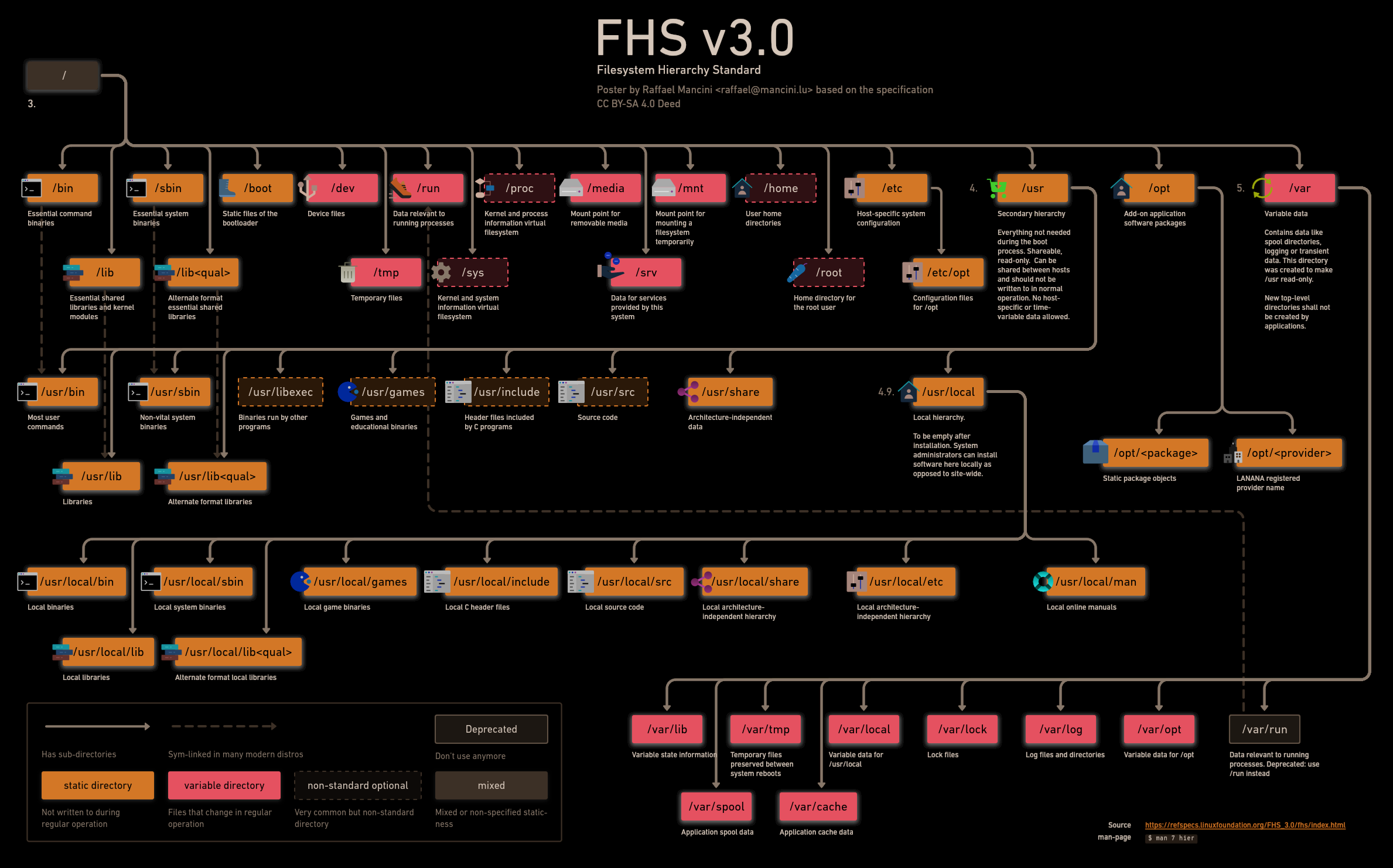Hey, I’ve recently designed a Poster about the FHS since I often forget where I should place or find things. Do you have any feedback how to make it better?
Edit: Put up new version

Dark mode
Dark mode?
Added!
Is that the only thing that changes between versions?
I added icons and corrected some things.
Thanks for clearing that up, But are these changes only available in dark theme?
Edit: rephrased the question.
i wonder why nixos adopted a different hierarchy…
I think because they want to have files from different packages separate and easily addable and removable using symlinks.
Also some things in the FHS make no sense for modern computers where storage is cheap and system storage is rarely shared amongst systems. The same applies for single-users/desktop machines. But it’s the only standard we have so, why not keep it for now.
thank you
But it’s the only standard we have so, why not keep it for now.
Because making new standards is fun.
I am new to Linux, is this the current “standard” file system?
Bonus tip: Many distros make this info available on the cli by including a “hier” man page that you can read using the command “man hier”.
Yes, it is. FHS stands for Filesystem Hierarchy Standard.
What an amazing cheat sheet then!
I’m about to print this out to add to my pile, thanks for taking the time.
This is really helpful, thank you!
I never understood why the shareable /usr is parent to the non shareable /usr/local. Wouldn’t a /usr/shared be way easier especially in the early network days?
If anyone has a link or some insights into this historical nitbit I’d highly appreciate it!
No comment on sensibility, but technically both are equally difficult - mount the parent filesystem, then mount the child filesystem into an empty directory in the parent. Doesn’t matter which one is where, it’s all abstracted away at this level anyway.
But when I mount a shared /usr on a remote machine it will always have the mount point /usr/local as empty folder - and either have an empty folder or have a mount target that is dependent on a network resource - that’s why for me it’s so unintuitive.
But then again I started with network stuff way more than a decade after all this got created 🤣
I think the idea at the time was that if /usr is unavailable, you won’t be doing much with the system anyway (other than fixing the configuration).Nevermind, apparently the original meaning had nothing to do with a network (TIL for me), so our discussion is kinda moot. See section 0.24 in this 2.9BSD (1983) installation guide
Locally written commands that aren’t distributed are kept in /usr/src/local and their binaries are kept in /usr/local. This allows /usr/bin, /usr/ucb, and /bin to correspond to the distribution tape (and to the manuals that people can buy). People wishing to use /usr/local commands are made aware that they aren’t in the base manual.
Ohhh now that is awesome and makes sense! Thanks a lot for that find :)
I’ve never seen
/etc/optused. Usually if an app is in/opt, the entire app is there, including its config which is frequently at/opt/appname/etc/.New to Linux, this is fantastic. Thank you.
I have 2 questions:
Do I understand the colors correctly in that /home is deprecated and shouldn’t be used? What’s the alternative in that case?
Where would you guys put configuration files for services? /srv seems like an adequate directory
I’m trying to remember this correctly, but traditionally /home is a symlink of /usr/home. I think that’s deprecated and you should now just have /home
The colors are confusing. I meant to mark /home as non-standard since it’s not mandated by the FHS.
The FHS doesn’t specifically mention the config of webservices but /srv seems good to me. Read https://refspecs.linuxfoundation.org/FHS_3.0/fhs/ch03s17.html for more info.
Edit: Changed colors
Where to mount permanent HDDs? Always thought it was in /mnt but the description says it’s for temporarily filesystems…
I think the FHS doesn’t really tell you where. In the end you can out them wherever you want as long there is no conflict with the FHS. Even /mnt/something seems fine. Just not really recommended.
man hier
New Lemmy Post: Filesystem Hierarchy Standard - Reference Poster / Cheatsheet (https://lemmy.world/post/9437468)
Tagging: #SelfHosted(Replying in the OP of this thread (NOT THIS BOT!) will appear as a comment in the lemmy discussion.)
I am a FOSS bot. Check my README: https://github.com/db0/lemmy-tagginator/blob/main/README.md







